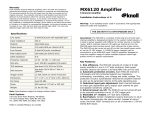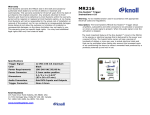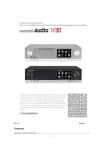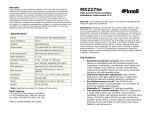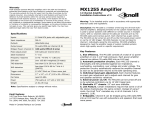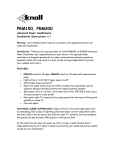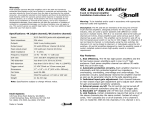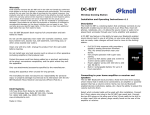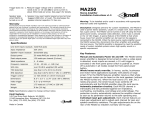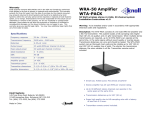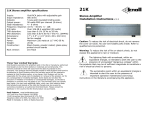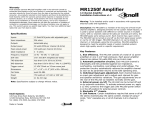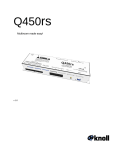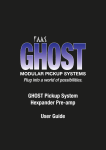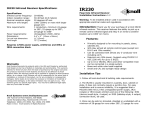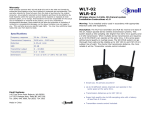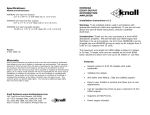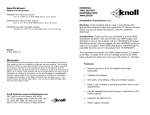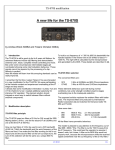Download KES400 KES600 - Knoll Systems
Transcript
KES400 and KES600 Eco-System™ Amplifier specifications: Inputs: Input impedance: Outputs: Output power: Peak output power: Ideal impedance: Frequency response: S/N ratio: THD distortion: IMD distortion: Dimensions: Fan noise: Power: Weight: Construction: 8 or 12 gold RCA jacks with adjustable gain 50k ohms 5 way gold binding posts 50 watts RMS per channel (8 ohms) 100 watts per channel (8 ohms) 4 – 8 ohms 10 Hz – 40 kHz +/- 1dB (1w) Over 105 dB A weighted (50 watts) Less than 0.1% 20 Hz to 20 kHz Less than 0.01% 60 Hz 7 kHz 4:1 (SMPTE) 17” x 3.5” x 11.5” (432 x 89 x 292 mm) Quiet 28 dBA Standby in Eco-System™ less than 5 watts Maximum 750 watts at 117 VAC or 230VAC KES400 20 lbs (9 kg); KES600 22 lbs (10 kg) Steel chassis, powder coated; glass epoxy printed circuit boards KES400 KES600 Eco-System Power Amplifiers Installation Instructions v1.3 Warning: To be installed and/or used in accordance with appropriate electrical codes and regulations. Introduction: Thank you for your purchase of a Knoll Eco-System multi-channel power amplifier and congratulations on your choice. This amplifier is specifically designed to save energy when idling, which can be most of the time. When compared to similar power amplifiers the KES400 and KES600 uses less than 5% of the energy required for normal amps to idle. FEATURES: Warranty Knoll Systems warrants its products sold in the USA and Canada by authorized Knoll dealers to be free of defects in materials and workmanship. This warranty extends for three full years from the date of purchase by the original consumer. Any products returned to Knoll Systems and found to be defective by Knoll Systems within the warranty period will be repaired or replaced at Knoll Systems option, at no charge. Knoll Systems will not be responsible for the actual cost of installation or removal of the product, nor for any incidental or consequential damages. Some states do not allow the exclusion or limitation of incidental or consequential damages, so the above limitation may not apply to you. This warranty gives you specific legal rights. You may have additional legal rights that vary from state to state. Knoll Systems www.knollsystems.com 145 Tyee Drive Point Roberts, WA 98281 14-7163 Vantage Way, Delta, BC V4G 1N1 tel (604) 940-1689, fax (855) 734-3363 KES400 and KES600 Made in Canada, 2011, Knoll Systems All Rights Reserved Eco-System™ Circuitry saves energy (and money) and increases power. 12 channels x 50 watts RMS at 8 Ohms (over 100W peak). KES400 8 channels. Individual and automatic channel resetting protection for low impedance, overheating, overloading, overvoltage and undervoltage. Individual gain controls for all channels. Electronic Link feature connects stereo inputs channel 2 through 6 to channel 1. KES400 connects stereo inputs channel 2 through 4 to channel 1. Side-mounted thermostatically controlled fan for internal cooling. Two rack spaces (3-1/2”) with optional rack mount version. The eco-friendly choice The Knoll KES400 and KES600 are class A/B amplifiers that produce 50 watts per channel at 8 ohms and 70 watts per channel at 4 ohms. While offering unparalleled reliability, power and sound quality the KES400 and KES600 offers a Knoll exclusive, the Eco-System™ circuit. This patent pending circuit determines which of the 12 stereo channels (6 pairs) are in use and delivers power only to those channels needing it. The channels that are “off” are truly off, not in “standby” or “mute”. With this circuit the active channels share more rail voltage resulting in more reserve power for the stereo channels in use. The most important feature of the Eco-System™ circuit is the electrical savings that is delivered to the owner over what a comparable class A/B amplifier will cost to operate. The typical homeowner will see a savings of a hundred dollars or more per year in actual electrical costs and that can be multiplied when taking into account the increased costs of air conditioning the home to extract unwanted heat produced by a typical multichannel amplifier. The KES400 and KES600 also feature a very quiet energy saving thermostatically controlled fan. A comparable amplifier without the Eco-System™ circuit (we should know, we make lots of them) uses about 14 times (65 watts) as much power while idling in standby. By comparison the KES600 with Eco-System™ uses under 5 watts while idling! For over 15 years Knoll multi-channel amplifiers have sold around the world because of their legendary reliability and unparalleled sound quality. The KES400 and KES600 take the next logical step by being eco-friendly. Please consider the environment when choosing your next system. Problem Action Power led does not light-no sound 1. Check that the KES400 or KES600 is plugged in. 2. Test the AC outlet with a lamp. 3. Check KES400 or KES600 power button is on (in). 4. Slowly turn down the “SENS” adjustment (counterclockwise) on the amplifier rear, until the amplifier just turns on. Sound cuts out 1. Verify speaker impedance is 4-16 ohms. Changing speakers may be required. 2. Check if the amp feels hot. If it's hot, increase cooling – see Installation. Sound is distorted 1. Turn the volume down. 2. Check speakers for damage. 3. Check inputs for proper levels. KES400 or KES600 gain and source output level may have to be adjusted. 4. Speakers may be less than 4 ohms. KES400/KES600 not turn off 1. Turn KES400 or KES600 power switch (out). 2. With the power switch on, and all input channels music source turned on, very slowly adjust “SENS” on rear of amplifier in a clockwise direction until amp turns off. Speaker pops when 1. Speaker may need resistor placed amp turned on or off across terminal. Suggest 2k0 1/4 w. This discharges the speaker internal capacitor. 8. Make sure the speakers in each room are connected in phase with the amplifier + going to the speaker +. Out of phase speakers give unstable imaging and poor bass response. 9. Connect the AC power into an outlet than can supply at least six amps (750 watts) dedicated to each KES400 or KES600. 10. After the amp has been turned on adjust the “SENS” pot on the rear of the amplifier if necessary. The “SENS” adjustment can be adjusted up (clockwise) to make the amp less susceptible to be turned on due to nuisance noise and hum. If it is adjusted too high, the amp may delay turn on or turn off during a quiet music or speech passage. Caution: Never listen to sound that is distorted. If distorted sound is heard, turn the volume down immediately or speaker and/or amplifier damage could occur that is not covered by the warranty. If this problem persists, contact your dealer. User Adjustments and Service: There are no user adjustments inside the KES400 or KES600. Your installer may make certain gain and sensitivity level adjustments on the rear panel. Caution: The KES400 or KES600 contains no user serviceable parts, so do not attempt to open or repair the KES amp. Refer servicing to a qualified technician only or contact the factory for information. Troubleshooting If a problem is encountered with the KES400 or KES600 amplifier, the most expedient procedure is to locate the problem and if possible repair it before requesting service. Be sure to carefully check other system components such as controllers, CD players, volume controls, wiring, speakers, etc. that may be at fault. Installation Installing the amplifier should be relatively easy. With a bit of planning, this amplifier will give trouble free service for years. 1. The most important consideration when installing the KES400 and/or KES600 is cooling. This amplifier has a lot of power packed into a small chassis size. When installing it in an equipment stack, it should be the top component. It needs at least 3"-5" of space above the amplifier to allow for adequate convection cooling. 2. When installing the KES400 and/or KES600 in a rack we suggest adding a 3-1/2" blank above and below the amplifier. In multiple KES400 and KES600 installations, plan for a 3-1/2" blank (double) between each amplifier and a 3-1/2" blank on the top and bottom. Amplifiers should always be the top components in a rack system. 3. The KES400 and KES600 are available as an optional 19" EIA rack mount style. 4. Never operate a KES400 or KES600 on its side, as the cooling potential drops significantly when operated on the side. 5. Connect the KES400 or KES600 RCA inputs to the source component outputs with good quality, short as possible RCA jack cables. Connect each channel individually. 6. Connect the KES400 or KES600 speaker outputs to speakers using good quality speaker wire. Minimum 16 gauge copper wire is recommended with 14 gauge minimum for runs over 30' (10m). Fire-rated wire may be required if installing wires inside walls, ceilings or floors. Note: Ideally the KES400 and KES600 amplifiers like 6-8 ohm loads. Connecting to 4-ohm loads won't hurt the amplifier, but the channels connected to 4-ohm loads may occasionally shutdown due to overloading. Never connect any KES400 or KES600 amplifier to less than 4 ohms. 7. Individually adjust the channel gains as required. Ideally, all gains are fully on (fully clockwise). KES600 Rear Panel The Link button is normally set to the in position to give all six stereo inputs individual sources. When a channel Link button is set to the out position, that channel is (Left/Right) linked or cascaded to input #1 (without the use of Y cords). Any or all combinations of linked inputs 2 to inputs 6 are possible. When all inputs are linked to input one, the input impedance is about 8500 ohms. Note: When linked unused RCA inputs can be used as outputs to other amplifiers. Caution: NEVER connect the KES400 or KES600 to impedances less than 4 ohms or amplifier damage not covered by the warranty may occur. The “SENS” pot controls the level threshold setting of the automatic power on and off to all channels. Each channel turns on and off individually. Power On Initially adjust the “SENS” on to about 1/3 level. Turn on a source to one or more channels and see if the channel turns on (observe the front panel led). With soft music on, the channel should sense the music and turn on. If it does not turn on, try turning the “SENS” adjustment counter clockwise slowly until the channel turns on. Power Off If the channel does not turn off about 3-30 seconds after a source has been muted or shut off, adjust the “SENS” slowly clockwise and wait 30 seconds. If it still does not turn off, turn it a bit more clockwise and wait another 30 Note 1: Ideal speaker impedance is 6-8 ohms. seconds. Keep doing this until the channel turns off in 330 seconds.





